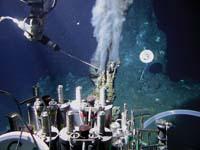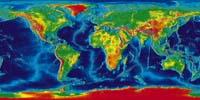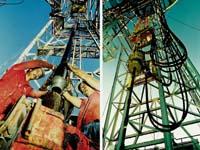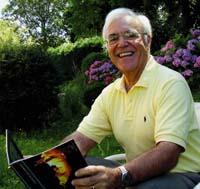2007/11/01
236. zenbakia

eu es fr en cat gl
Aparecerá un contenido traducido automáticamente. ¿Deseas continuar?
Un contenu traduit automatiquement apparaîtra. Voulez-vous continuer?
An automatically translated content item will be displayed. Do you want to continue?
Apareixerà un contingut traduït automàticament. Vols continuar?
Aparecerá un contido traducido automaticamente. ¿Desexas continuar?
The seabed, an unmistakable universe
Text created by automatic translator Elia and has not been subsequently revised by translators.
Elia Elhuyar
In the 1960s, the conquest of space was fashionable. Americans and Russians played a scientific and technological career, who came farther, who discovered more amazing worlds in a broad space. But at the same time, some scientists began to investigate another unexplored universe. And they saw that some keys to understanding the world we tread with our feet were at the bottom of the sea.
The seabed, an unmistakable universe
01/11/2007 | Galarraga Aiestaran, Ana | Elhuyar Zientzia Komunikazioa

The knowledge of the hydrothermal chimneys of the marine background has contributed to completing the theory of plate tectonics.
New Hampshire Univ.
For centuries, geographers, geologists and oceanographers believed that the seabed was a purple zone, without activity or life. Without further ado, the seabed was considered the place where the products of continental erosion and the skeletons of the animals that inhabit the surface accumulate.
This vision did not change until the 1960s. It is at this time when ocean bottoms begin to be explored. Until then the technology was not as advanced as to go down to the bottom of the sea, but in 1964 the Americans embarked on Alvin. Just as Apollo designed to go to the Moon, they made a submarine that could accommodate three people inside to reach the bottom of the sea, and today Alvin continues to drag people into the depth of the sea.
Scientists are largely due to submarines like this.
Traces of plate tectonics

The oceanic dorsal, sixty thousand kilometers long, crosses all the oceans of the world.
NOAA
Among other things, shipments made in manned submarines have contributed to completing the theory of plate tectonics. In fact, in the global oceanic dorsal scientists have flooded numerous occasions and have closely observed the evidence of the appearance of the new surface.
According to the theory of plate tectonics, ocean expansion moves continental plates. And that movement occurs precisely in the dorsal. In the axis of the dorsal volcanic eruptions occur and large lava flows are emitted. They are generally basaltic fences that form a new surface. As new eruptions occur, the ground surface areas of new creation move away from the axis.
They move a few centimeters a year to the sides, so in the temporal scale of the human being the movement does not stand out. But in geology time is measured in millions of years, and in a million years the bottom is tens of kilometers away. Thus, tens of millions of years, they are hundreds or thousands of kilometers from the dorsal where the oceanic funds were formed.
As it moves away from the dorsal, the ocean surface is cooled and its density increases. When the density of this ocean surface is greater than that of the lower mantle, it sinks. The sinking zone is called a subduction zone. In the mantle, the earth's crust melts, so, as the geologists indicate, the crust is "recycled", which completes the process of forming the terrestrial surface.

The low emission of lava in the eruptions that occur in the dorsal gives rise to pillow structures (photo left). If large amounts of lava are poured, lakes structures (on the right) form.
(Photo: T. T. Juteau)
All this, of dorsal oceanic origin, has a length of 60.000 km and crosses all the oceans of the world. Except in Iceland and elsewhere, it is under water and the ridge is at an approximate depth of 2,500 meters. The dorsal itself stands between 2,000 and 3,000 meters above the abyss valleys that separate it from the continents.
Submarine volcanoes
However, there are still many questions to answer about volcanic activity on the seabed. For example, so far no one has objected at the time a rash is occurring. On the contrary, thirty-four years ago, they discovered the clear traces of ocean expansion. He participated in the Famous operation (French American Mid Ocean Undersea Survey), driven by American and French scientists, in 1973-74. Led by geologist Xavier Le Pichon, they explored the rift located about 700 kilometers south of the Azores, the deep valley that divides the ridge of the central dorsal of the Atlantic. Its aim was to discover the traces of ocean expansion.
In this operation, in addition to Alvin, they used the Archimede Baton and a French underwater crew, Cyana. From within, scientists saw for the first time a surprising world of basalt. The operation was really fruitful, as the submarines allowed them to walk on the bottom of the ocean and see with their eyes the newly created surface. In addition to seeing, images were taken and samples were taken and various physical-chemical parameters were measured at the site.

The drilling boat allows to analyze the composition and structure of the oceanic crust, as well as the sediments that cover it.
T. T. Juteau
After Famous came more expeditions to explore the ocean floor. In these explorations, in addition to the submarine, the drilling boat was used. The drilling boat is very useful for geologists as it collects cylindrical columns of 6 cm of diameter and several meters of length. In this way, we can study the composition and structure of the oceanic crust, as well as the sediments that cover it.
Hydrothermal fireplaces
Famous's next known exploration was Cyamex in 1978. By then, geologists were fascinated by the structures generated by the eruptions that occur in the dorsal. The basaltic magma leaves at 1,200 °C and the sea water is at 2 °C. Therefore, its solidification is immediate and its appearance varies depending on the volume poured. If not much lava is poured, structures are created in the form of pillow (pillow lava). They are of various forms, often similar to tubes. On the contrary, when much lava is poured, the lava occupies all the grooves and flat structures like lakes are formed.
In the Franco-Mexican operation Cyamex, at the entrance of the Gulf of California, in Mexican waters, discovered other structures hitherto unknown as hydrothermal chimneys. One day a Mexican scientist descended inside Cyana and saw a special structure of vivid colors. On it were found remains of dead animals, as the shells that begin to undo. Other dives were then carried out in the area, finding remains of hot currents, fossils of worms, dead clams and more chimneys. But all were dead.

The hydrothermal chimneys are metallic constructions.
Max Planck Institute
Suddenly... oasis
The following year, in 1979, with the aim of finding active hydrothermal fireplaces, French and American scientists returned to the same place in Operation Rise. They took the Angus to take photos of the background. The place was chosen with Sonarra and on the volcanic chain thousands of photographs of the background were taken. In them it was observed if there were remnants of life. According to this, the place where to dive was chosen, within Alvin.
Thus they discovered the first active fireplaces. He was the emeritus professor at the University of Brest, geologist Thierry Juteau, who first discovered the ecosystem around them. In the dark, at a depth in which the ocean seems purple, thousands of animals gathered around spectacular fumaroles that poured black water: crabs, octopus, fish, worms, giants... In fact, fumaroles emit carbon dioxide, methane and, above all, hydrogen sulfide dissolved in hot water (the water leaves at 350 °C). Therefore, the environment is conducive to the growth of anaerobic bacteria with which numerous invertebrates and vertebrates coexist in symbiosis.
The fumaroles themselves are "metallic constructions". Dissolved in water are extracted metallic sulphies that when coming into contact with the cold water of the ocean precipitate immediately. This creates pyrite structures (FeS 2), calcopirite (CuFeS 2), soft (ZnS) and galena (Pb S) slightly, and calcium sulfate (CaSO 4) white. Other mineral salts (iron hydroxides, manganese and cobalt) float on the chimney to 200-3.000 meters and gradually accumulate on the basaltic rocks of the area forming a black bark.

At the bottom of the ocean, in a world that seems totally purple, thousands of animals gather around the fumaroles.
T. T. Juteau
Since then, scientists have shown that fumaroles are part of the hydrothermal system of the seabed. The cold water of the ocean sinks by the cracks of the earth's crust. When lowering dissolves the minerals of the rocks. Under the Earth's surface, at the top of the magma chambers, high-temperature reactions occur. Then, the hydrothermal fluids are extracted from the chimneys in the form of black fumarole, whose flow can be more than one cubic meter per second. The entire system is essential for the composition of marine water to be stable.
The exploration of the seabed is not over, but it is clear that as technical advances allow us to better know the underwater universe. In addition, economic interests are also driving exploration of the ocean bottom: the depletion of surface mines has led to new sources. And the dorsal ocean is a large warehouse of metals.
Small explorers
Until the 1960s, batisfatos were used to descend to the seabed. With them, spectacular records were made. For example, in the 1960s, the French batiskafo Archimede managed to reach 10,800 meters deep in the Mariana trench. However, these dives had no major scientific objectives. In fact, batisfatos were not suitable for exploring the bottom, they were very heavy (200 tons) and were not able to move around the bottom.
In 1964, the first manned submarine specially designed to investigate the seabed was formed: Alvin . He and his later fellows revolutionized the exploration of the seabed. They are submarines resistant to high depth pressure, at the same time light. Alvin, for example, weighs only 17 tons, but its titanium and iron sphere supports well the pressure at 4,500 meters depth, maximum that can reach Alvin.

Submarine Alvin.
(Photo: Max Planck Institute)
To get to that depth, Alvin takes about two hours to climb and so many others. In each dive, a maximum of ten hours remains submerged with a pilot and two scientists inside. Thus, scientists have between 4 and 6 hours to observe the environment lying on the floor by the windows, taking photos and making films, collecting samples through the robotic arm and experimenting on the ground. However, Alvin carries inside, just in case, enough oxygen for three people to spend 72 hours.
Its movement capacity is unlimited thanks to six reversible thrusters. In this way, you can stay floating to the depth you want, stand in the background or navigate on the bottom following a rough relief. The sinking and outcropping is done simply by gravity and buoys.
In total, Alvin has made more than 4,200 dives and has led 12,000 scientists, engineers and observers to the ocean depth. Since its creation has been very renewed, for example, in 2006 another robotic arm was placed. But there are basic things that cannot change, so they are making their substitute. However, the first small explorers have done a unique job in exploring the ocean floor.
Thierry Juteau: "I will never forget what I saw on April 21, 1979"
Thierry Juteau is known for being a good geologist and a great communicator, but especially for having had the opportunity to see the hydrothermal chimneys for the first time. We stayed with her in a talk she offered in Zumaia about this discovery. So, recently, Juteau has welcomed us in his house in Hendaia and, calmly, has explained to us his experiences and investigations with great kindness.
You studied geology, how does your interest in marine bottoms arise?
I studied university in the early 1960s, and at that time there was no talk of the ocean because it was totally unknown. In fact, I began to study the Ofiolites. The ofiolites are fragments of the ancient oceanic crust, currently on the continental crust. And the similarity between them is enormous: In Oman is the world's largest opera house and, when I am there, I have the feeling of being on the bottom of the sea.

(Photo: A. A. Galarraga)
But we still did not know what the seabed was like. Then, in the 1960s, the Americans began to draw up the map of ocean bottoms, which were those who saw the oceanic dorsal. And at that time the theory of plate tectonics (1967-68) also arose, and they began to think that the dorsal had an important function there. Thus, being my specialty the fossil dorsal, I arose the desire to see active dorsal.
And you had the opportunity to fill with desire.
Yes, I was very lucky because then geologists began to participate in expeditions. In fact, at the bottom of the sea were made the necessary instruments to carry out geological investigations: small submarines like Alvin and Cyana, and a drilling boat. In fact, in the drilling boat I made two campaigns, one as mission director.

Oman's office is the largest in the world and was investigated by Juteauri.
(Photo: B. B. Hacker/University of California)
But I wanted to study the submarine. I could not participate in Operation Famous, but for the next, Cyamex expedition, I made the request and I was accepted for being a specialist in crafts. This mission was very important, we discovered a lot of interesting structures, but it ended before we could find active fireplaces.
However, the following year we returned there, on the Rise expedition, and then yes, for the first time I had the privilege of seeing hydrothermal ecosystems. It was on April 21, 1979 and I will never forget it. It was mind-boggling.
Have you continued to investigate the ocean bottom ever since?
Yes, I have made many shipwrecks, but I have always kept a place on land: Ofiolite of Oman. For me it is a beloved place. I started studying it in 1981 and I still go.
Galarraga de Aiestaran, Ana
Services Services Services
236 236
2007 2007 2007 2007 2007
Results Results Results
030 30 030 030
Geology; Oceanography; Technology; Biology
Article Article Article
Information about information














